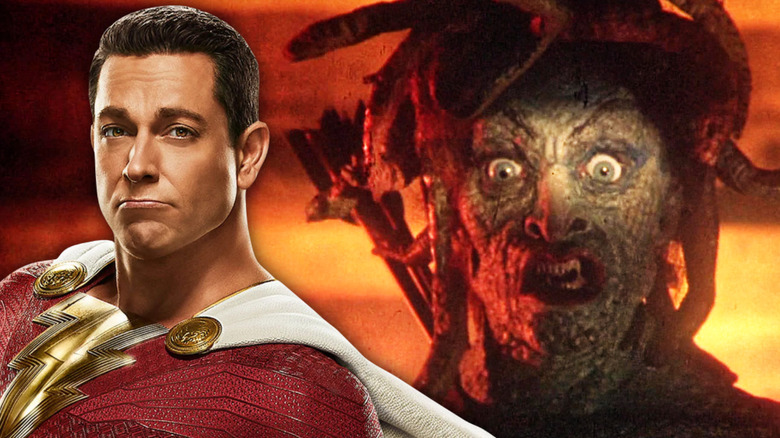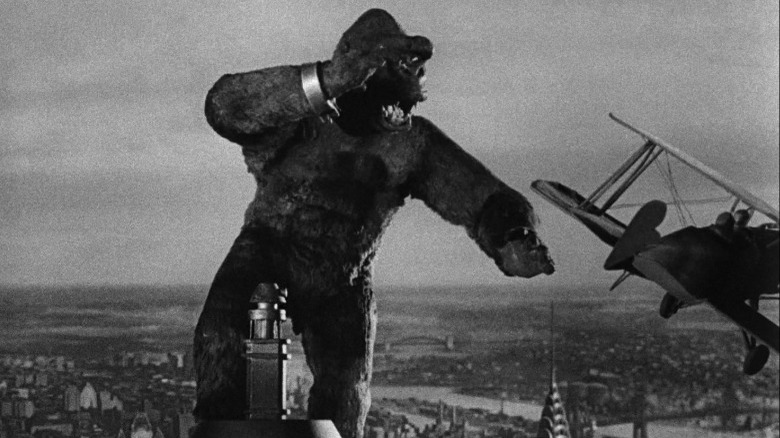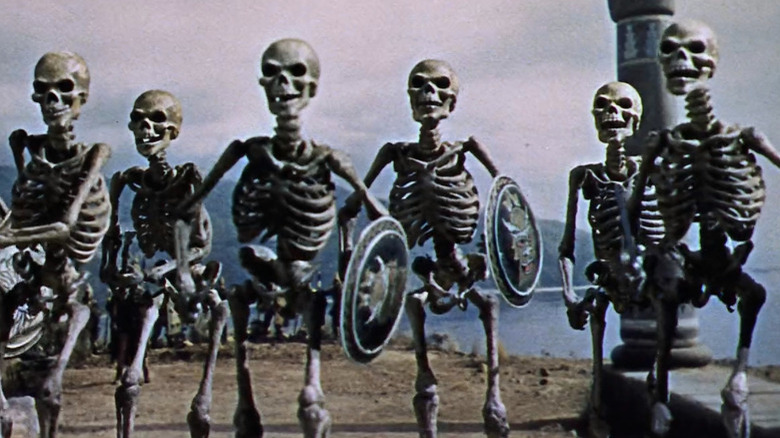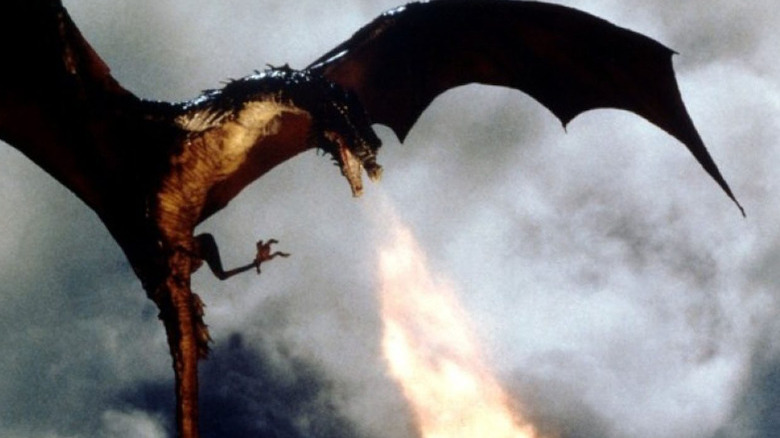Shazam 2's CGI Monsters Make Us Miss The Days Of Stop-Motion
If there's one thing we can take away from modern blockbusters it's that, with rare exceptions, special effects just don't feel "special" anymore.
That's not to say that there aren't beautiful and convincing visual effects being produced in the world of cinema. "Top Gun: Maverick" seamlessly blends real aerial footage with CG recreations, to the extent that it's nearly impossible to tell what was really in front of the camera. "Avatar: The Way of Water," whatever its other flaws may be, is a sumptuous spectacle for the eyes, at once vibrant and colorful and creative.
But what so very many modern visual effects films have in common is that they take imagery that should be astounding for granted, treating the most incredible and impossible things the human mind could devise, and acting like it's just something everyone deals with every day. And the new superhero film "Shazam! Fury of the Gods" is one of the weirdest offenders. It treats a magical fountain pen with awestruck wonder and the most fantastical creatures from Greek mythology like they're generic cannon fodder.
It didn't used to be that way. "Shazam! Fury of the Gods" may not be an exciting fantasy spectacle, but at least it reminds us that for all these wonders at our modern fingertips, no films have captured the wonder of legendary monsters like the stop-motion classics.
The eighth wonder of the world
Stop-motion is an animated process in which filmmakers take real objects and models, photograph them, move them slightly, and then photograph them again. When these photographs are put together in a motion picture, the motionless objects appear to move on their own. When done well, the effect is uncanny, creating images that should be impossible to photograph on camera, with real-life texture and weight.
While many animators use stop-motion to create entire animated worlds, in films ranging from "The Nightmare Before Christmas" to "My Life as a Zucchini" to "Guillermo del Toro's Pinocchio," filmmakers have long used stop-motion to create visual effects in otherwise live-action motion pictures. This technique dates all the way back to the silent era, in various short films from filmmakers like Georges Méliès, and features like "The Lost World" (1925), which featured dinosaurs seemingly interacting with real actors in an adaptation of the classic adventure by "Sherlock Holmes" creator, Sir Arthur Conan Doyle.
The stop-motion effects in "The Lost World" came courtesy of Willis O'Brien, who would later use those techniques to create one of cinema's most enduring icons: the gigantic gorilla "King Kong," in 1933. The visual effects spectacular, a heightened version of then-popular safari pictures, found a crew of explorers on an uncharted island full of dinosaurs and other unspeakable monsters. When the island's undisputed ruler, King Kong, falls in love with one of the explorers, he's captured and taken back to New York City and treated like a spectacle, only to run amok, climb the Empire State Building, fight off a swarm of biplanes, and fall to his tragic death, misunderstood as any of the great movie monsters.
"King Kong" may not be entirely convincing to modern eyes, but there's a magic to his existence, at once very real yet totally dreamlike. King Kong truly existed, even if in reality he was only 18 inches tall.
Skele-tons of fun
The influence of "King Kong" on visual effects is difficult to quantify, but we know for a certainty that the film inspired visual effects maestro Ray Harryhausen to take up the painstaking craft of stop-motion. Harryhausen worked with Willis O'Brien on another giant ape movie, the 1949 fantasy film "Mighty Joe Young," before going on to make a name for himself as the creator of iconic beasts in a wide range of genre-defining classics. "20 Million Miles to Earth," "The 7th Voyage of Sinbad," "Jason and the Argonauts" and "Clash of the Titans" are but a few of the beloved films that introduced impressive, bizarre, and believable fantasy creatures to audiences around the world.
It's nothing short of amazing to watch a film like "Jason and the Argonauts" today and discover that, despite the many extreme changes in cinematic storytelling that have come about in the 60 years that followed, the monster effects are still dazzling. They may not look realistic, the way that modern visual effects often do, but in this context, that's a good thing. In real life, skeletons don't climb out of the ground and attack you with swords. Stop-motion animation, by design and by nature, looks a little bit surreal, and that gives the effects created with this technique a larger-than-life, jaw-dropping quality. You can't believe what you're watching but you're watching it anyway.
It's a lot less painstaking to craft CGI effects today than it was to create them in stop-motion over half a century ago, and that meant that stop-motion animators were usually very careful to choose camera angles that really showed off the spectacular work they were doing. The best stop-motion visual effects movies don't let a jaw-dropping image flicker past you in the blink of an eye, and they make damn sure you can see how cool it looks. Those films treat their imagery like pieces of wonder. They don't toss them aside as a joke.
Portrait of a dragon on fire
Stop-motion animation would be used for a variety of major motion pictures, and it improved over time. The awe-inspiring dragon Vermithrax Pejorative, the title monster in the Disney classic "Dragonslayer," was created using an innovative technique called "Go-Motion," where instead of capturing still images and assembling them, the model would move slightly in each frame to create a more realistic sense of motion blur when the effect was completed. There's a reason why "Game of Thrones" creator George R.R. Martin once called Vermithrax Pejorative "the best dragon ever put on film."
Vermithrax Pejorative, who clearly has the best name of a dragon ever, is distinct and terrifying. It moves like a mythical beast, at once unnatural and wholly believable, and its realistic construction makes it seem like it shares the same space as the live-action performers who share the screen. The dragon in "Shazam! Fury of the Gods" can't make any similar boasts. It's shiny and clean, and if the way Lucy Liu rides it is any indication, it moves more like a clunky amusement park ride than an actual living creature. It may be big but there's no grandeur to the giant dragon in "Shazam 2," nor do the other mythical creatures appear to have much heft or even personality. Most of the time they're just stuff moving around the screen.
As dated as some of the old stop-motion VFX classics may be, their special effects still feel special, because they were treated by the filmmakers as something unusual and wondrous. The matter-of-fact fantasy of films like "Shazam! Fury of the Gods" just can't compete.



